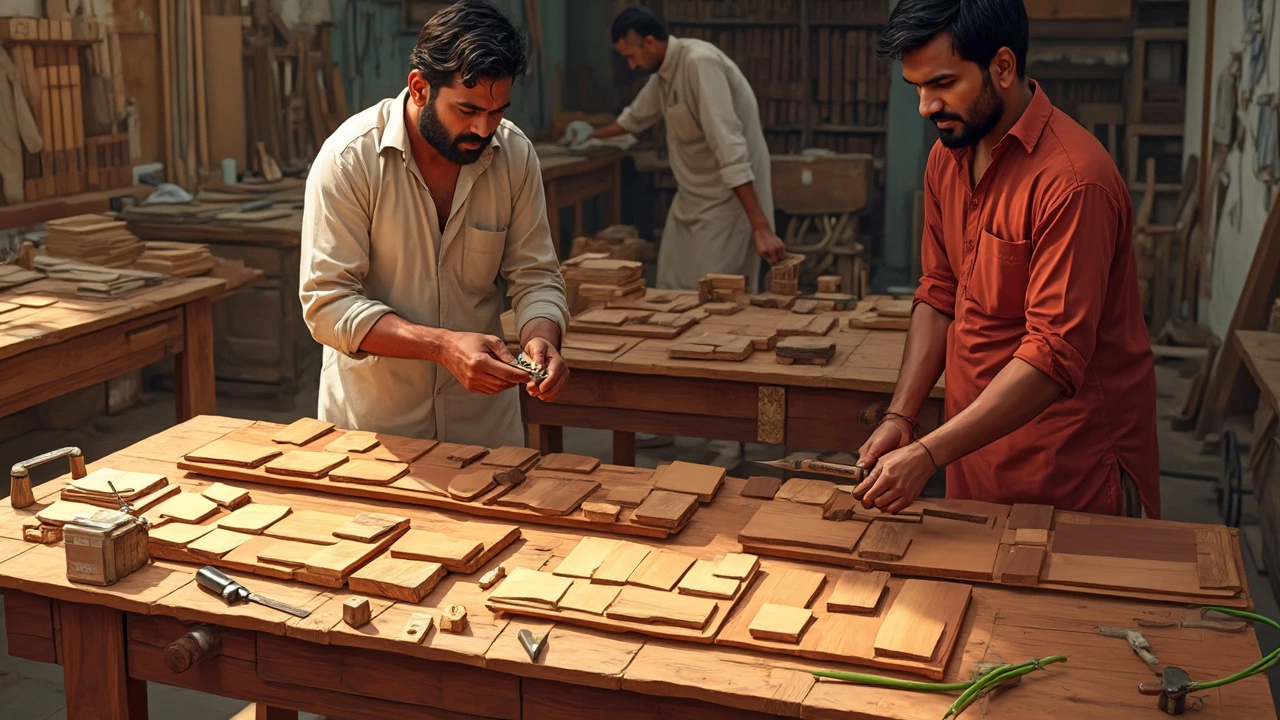 May, 13 2025
May, 13 2025
Ever wondered why your neighbor's old chair still looks brand new while your coffee table already has wobbly legs? It all comes down to wood choice. In India, not all trees are created equal for furniture-making, and picking the right kind makes a world of difference. It’s like picking the right cricket bat—some give you power, others just break mid-game.
Buying from Indian furniture manufacturers? They know their woods—some swear by teak, others won’t touch anything but sheesham. If you’re stuck between price, strength, and looks, there’s no single answer, but there are smart ways to narrow it down. Whether you're shopping for a new dining table, getting custom shelves, or planning to pass down a wooden bed to your kids, starting with the right wood means less regret—and fewer repair bills—later.
- Why Wood Choice Matters for Furniture
- Popular Indian Trees for Furniture
- Teak vs Sheesham: The Real Showdown
- Budget-Friendly and Eco-Friendly Options
- How to Spot Quality Wood Furniture
Why Wood Choice Matters for Furniture
If you think any wood will do for your next sofa or dining set, think again. Choosing the right wood changes everything—how long your furniture lasts, whether it survives the monsoon season, and even how it looks ten years down the line. In India, furniture has to deal with crazy humidity, heat, and plenty of use. Some woods just can't keep up.
Hardwoods like teak and sheesham aren’t just more durable—they’re less likely to warp, crack, or get eaten by termites. One famous survey by the Indian Institute of Wood Science listed teak as one of the most stable woods for Indian weather, while lightweight woods like mango or rubberwood need extra care and finish to avoid swelling or splitting.
The choice of wood also affects the price big time. Go for premium stuff like teak, and you’ll pay more upfront, but you might save on repairs or replacements years down the road. Cheaper wood can look good if made well, but might not handle kids jumping on it or repeated shifting anytime you move houses (trust me, I’ve played musical chairs with enough sofas during relocations).
Here’s what people usually get wrong: thinking all solid wood is the same. That’s just not true. The grain, density, resistance to bugs, and even how it takes to polish all depend on the species. If you want furniture that lasts, you need to match the wood to your home’s climate, your budget, and how rough your family gets with it.
To sum it up, your choice affects:
- Furniture life span
- Maintenance needs
- Looks and color over time
- Resistance to bugs and weather changes
That’s why most furniture manufacturers in India fuss a lot about the best wood for furniture India. Making the right call is less about looks and more about surviving daily life—and our weather.
Popular Indian Trees for Furniture
If you walk into any decent Indian furniture store, you'll hear the same big names pop up again and again—teak, sheesham, mango, sal, and acacia. These aren’t just marketing fluff; they actually make a real difference to how your furniture lasts, looks, and handles daily wear.
- Teak: This is the king when it comes to Indian wood furniture. People like it because it lasts ages, doesn't warp too easily, handles moisture, and even repels termites. No wonder it’s pricey—good quality teak can last more than 50 years, sometimes even longer if you take care of it.
- Sheesham (Indian Rosewood): Known for its rich and bold grain, it looks fancy and holds up well in humid conditions. It’s not as expensive as teak, but still gives solid, reliable furniture. Many family homes have sheesham beds and cabinets that get handed down for generations.
- Mango Wood: If you want something that’s solid but lighter on your wallet and the environment, mango is a great pick. It grows fast, so it’s sustainable, and it works well for just about anything— chairs, tables, beds. But it can be softer compared to teak or sheesham.
- Sal: You’ll see a lot of sal in old railway furniture and office desks. It’s heavier than mango and fights off bugs naturally. It doesn't look as striking, but if you want pure functionality, it’s a safe bet.
- Acacia: This one’s getting popular because it's tough and usually cheaper than teak. The best thing? Its grain and color have that modern, rustic vibe—a win for new-age homes.
Here’s a quick side-by-side to make things simple:
| Wood Type | Strength | Durability | Resistance to Termites | Price Range (per cubic foot) |
|---|---|---|---|---|
| Teak | Very High | 50+ years | Excellent | ₹3,500–₹10,000 |
| Sheesham | High | 30–40 years | Good | ₹1,500–₹5,000 |
| Mango | Moderate | 15–20 years | Fair | ₹1,000–₹2,500 |
| Sal | High | 25–35 years | Very Good | ₹1,200–₹4,000 |
| Acacia | High | 20–25 years | Good | ₹1,200–₹3,200 |
Each of these trees brings its own perks. Teak and sheesham are the mainstays if you want something reliable and classic-looking. Mango and acacia offer a budget-friendly spin for more modern or eco-conscious buyers. And sal is that old-school tough guy—maybe not a showstopper, but it gets the job done and then some.

Teak vs Sheesham: The Real Showdown
Walk into any furniture shop in India and you’ll hear the big debate: should you go for teak or sheesham? Both are top picks for Indian furniture, but each has its own strengths and quirks. Let’s break it down and make it simple.
Teak wood is like the celebrity of Indian woods. It’s naturally oily, which makes it seriously weather-resistant and pretty much bug-proof. That’s why it’s often used for outdoor benches or heritage beds that are passed down for generations. If you want zero-fuss maintenance or something that just lasts, people say you can’t go wrong with teak. But here’s the flip side: good teak isn’t cheap. Premium Indian teak (like from Kerala or Central India) costs about ₹3,000 to ₹8,000 per cubic foot, depending on quality and grain.
Now, let’s talk sheesham, also called Indian rosewood. Sheesham gives you rich color, lovely grain patterns, and super toughness. It handles moisture better than softwoods, though not quite like teak. Still, you’ll find sheesham beds and tables looking solid after decades. Carving work? Sheesham wins—its texture makes detailed designs pop. Plus, it’s more budget-friendly: Indian sheesham usually costs ₹1,800 to ₹3,500 per cubic foot.
To make this shootout easy, check out this quick comparison:
| Feature | Teak | Sheesham |
|---|---|---|
| Durability | ★★★★★ | ★★★★☆ |
| Maintenance | Very low | Low |
| Pest/Termite Resist | Excellent | Good, if treated |
| Best For | Any weather, outdoors | Indoor furniture, carving |
| Grain Look | Even, golden-brown | Varied, reddish-brown, dramatic |
| Price (per cubic foot) | ₹3,000–₹8,000 | ₹1,800–₹3,500 |
If you’re after a showpiece for your living room or you want to dodge maintenance worries, teak does the job—especially if you live somewhere humid or coastal. But if you love furniture with bold character (and want to save some cash), sheesham is a strong contender. One thing people often forget: check for fake wood. Some sellers pass off ordinary wood as teak or sheesham. Ask for authenticity certificates or at least see the grain yourself before buying.
Bottom line—there’s no single best. Think about your room, budget, and how much you care about long-term care. Then match the wood to your needs, not just fancy names.
Budget-Friendly and Eco-Friendly Options
If your wallet isn’t loving the idea of solid teak or sheesham, don’t worry—there are plenty of other woods that are both affordable and good for the planet. When hunting for furniture in India, the choices go beyond the status symbols. Three wood types stand out if you care about savings and sustainability: mango, rubberwood, and acacia.
Best wood for furniture India sometimes means looking at lesser-known trees. Mango wood is super common these days, and for good reason—it grows fast, so it's more sustainable, and after its fruiting years are over, the trees get cut down anyway. Rubberwood is another winner; it’s actually a by-product of the latex industry, so farmers chop them after their latex days are done. This means you’re not putting extra pressure on forests that are already being logged too much.
Here’s a quick comparison to show how these budget woods stack up in the real world:
| Wood Type | Price Range (per cubic ft) | Durability | Eco-Friendliness |
|---|---|---|---|
| Mango Wood | ₹1200 - ₹1800 | Good for daily use | High (fast-growing, reused trees) |
| Rubberwood | ₹1000 - ₹1600 | Moderate, best for indoor furniture | High (repurposed plantation wood) |
| Acacia | ₹1400 - ₹2000 | Tough, water-resistant | Medium (fast-growing, but not always from managed sources) |
Want to make sure your purchase doesn’t leave a big dent in the environment? Ask if the wood is FSC certified, which basically means it comes from forests managed with care—so no dodgy logging. Also, second-hand furniture is way more sustainable than anything new off the shelf, especially if you can refinish it yourself or hire a local carpenter (trust me, they’re amazing at turning old wood into something cool).
- Look for furniture brands that use reclaimed or certified wood.
- Sometimes engineered wood (like plywood or MDF) is a decent choice, but double-check for formaldehyde or other nasty chemicals.
- For everyday stuff (bookshelves, kids’ desks), mango or rubberwood are much better for the environment and your pocket.
Bottom line: You don’t have to shell out for premium wood to get sturdy, stylish, and responsible furniture. It’s about asking the right questions and knowing these overlooked Indian woods can get the job done—without hurting your budget or the forests.

How to Spot Quality Wood Furniture
Picking up a wardrobe or a table? Don’t just trust the seller’s word—look for signs that show you’re getting solid, honest wood, not a cleverly disguised knockoff. Years ago, I bought a cheap bed that looked great, but it turned out to be laminate over particleboard. Lesson learned. Here’s how not to get tricked.
- Best wood for furniture India—If you see names like teak and sheesham on the label, that’s a good start. These woods have a unique, rich texture that’s hard to fake. Ask if you can see the unfinished areas (like under the seat or inside a drawer). Real wood has grain you can feel, not just a printed pattern.
- Check weight—Quality wood furniture is heavy. If a big table feels strangely light, it’s probably not solid wood. For example, a proper sheesham or teak wardrobe can easily need two adults to move it.
- Joints matter—Look underneath and at the corners. Traditional joinery (like mortise and tenon, or dovetail) is a strong sign. If you only see lots of screws or glue, that’s a red flag.
- Finish and polish—Run your hand over the surface. Is it smooth, with no rough patches, dents, or sharp edges? A good finish means the manufacturer cared about durability. Cheap polish will peel off in a few months.
- Look for cracks and warps—Natural wood can move, but too many big cracks, splits, or a twisted leg show poor seasoning (drying). Properly dried wood doesn’t warp easily.
- Ask about pests—Indian wood can attract termites if not treated. Genuine, reputable places will have no problem showing proof of anti-termite treatment.
One bonus tip: If you’re in a showroom, ask to see a cross-section. Real wood looks the same through the cut, not like a sandwich with a thin top layer. Your wallet will thank you in a few years.